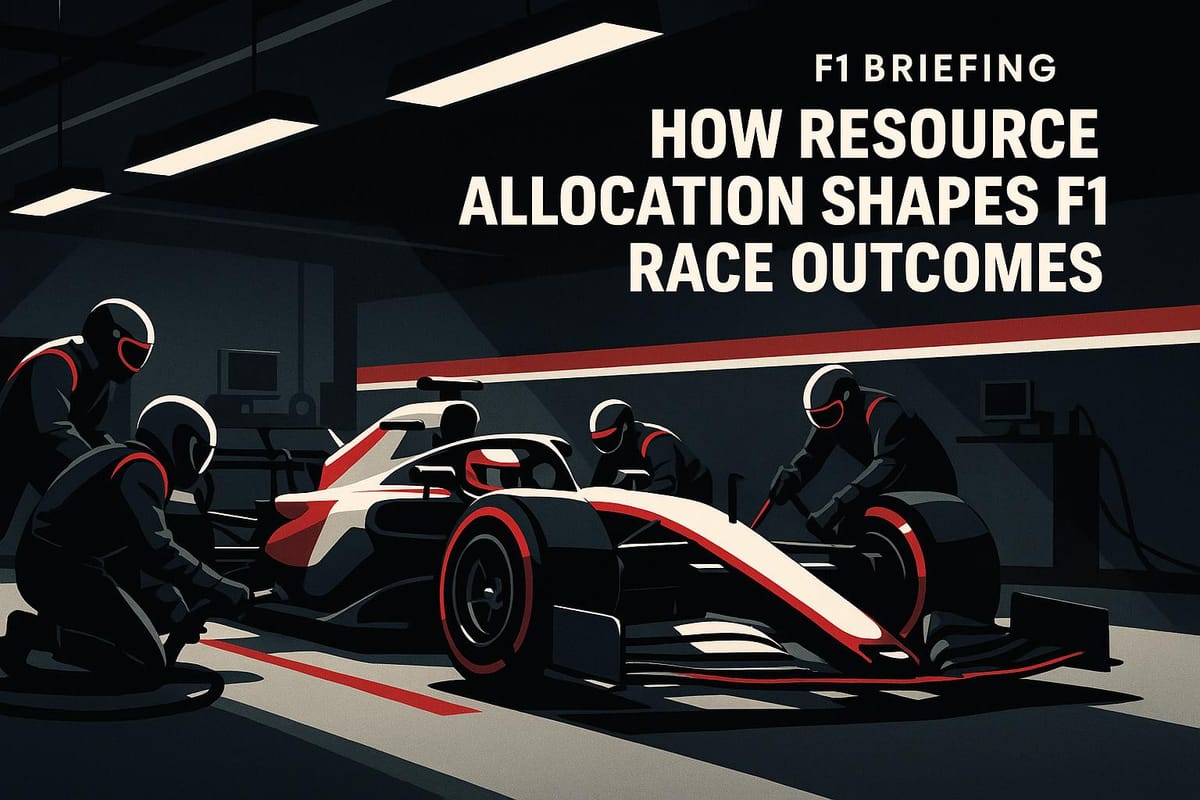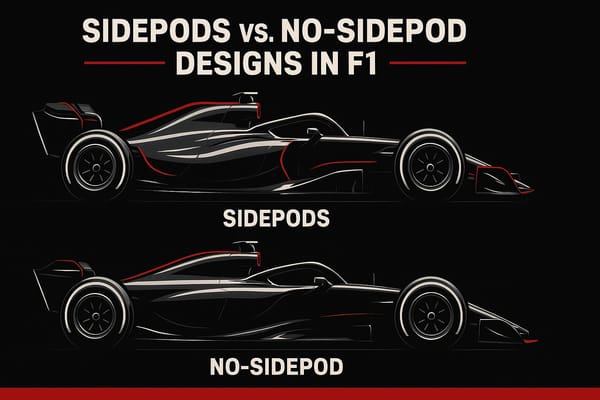How Resource Allocation Shapes F1 Race Outcomes
Resource allocation in F1 is crucial for success, balancing budgets, technical limits, and personnel strategies to enhance competitiveness.

Formula 1 success hinges on smart resource allocation. Teams must carefully manage budgets, technical limits, and personnel to perform under strict regulations like the $135 million cost cap and aerodynamic testing restrictions. Missteps can cost points, while well-planned strategies boost competitiveness.
Key takeaways:
- Budget Management: Teams allocate funds between immediate race needs and long-term car development. The cost cap excludes driver salaries and marketing, creating strategic spending opportunities.
- Technical Constraints: Engine development freezes and wind tunnel hour limits push teams to maximize efficiency with data and simulations.
- Personnel Strategy: Effective staff rotations and data-driven decisions improve race-day performance and long-term results.
Recent examples highlight how Mercedes, Ferrari, and Red Bull excel by prioritizing efficiency and focusing on high-impact upgrades. Meanwhile, teams like Williams and McLaren show how poor planning can hurt competitiveness.
The 2026 regulations will further test teams, requiring simultaneous development of hybrid-electric power units and new chassis designs. Teams leveraging data analytics and balancing short-term and future planning will lead the next era of F1.
How F1 Teams ACTUALLY Spend $350M a Year (ft. Guenther Steiner)
Main Resource Allocation Problems in F1
F1 teams face three major resource challenges that can significantly influence their performance and championship standing. In the cost cap era, making the most of limited resources has become an even more complex puzzle. Let’s dive into the financial, technical, and personnel challenges shaping the sport.
Managing Financial Budgets
The $135 million cost cap for 2025 forces teams to carefully balance their spending each season. This cap covers most car development and operational costs, but teams must still decide how to split funds between immediate race needs and long-term projects. Typically, teams set aside a flexible reserve of 10–25% of their budgets to handle unexpected challenges.
A tiered system further complicates matters, with development budgets capped at $51 million for top teams, $58 million for midfield teams, and $65 million for backmarkers. Meanwhile, driver salaries, marketing, and sponsorship activities fall outside the cost cap, leaving teams to allocate resources strategically between these uncapped areas and technical development. For instance, Williams Racing in 2022 prioritized efficiency improvements and heritage-driven marketing efforts, opting to accept short-term performance sacrifices to ensure long-term financial stability.
Technical Resource Limits
In addition to financial constraints, technical limits have reshaped how teams approach car development. Since the engine development freeze in 2022, teams like Ferrari have had to focus on refining existing components rather than creating new ones, fundamentally altering their strategies for improving power unit performance.
Aerodynamic testing is another area where resources are tightly controlled. The aero handicap system restricts wind tunnel and computational fluid dynamics (CFD) hours for top-performing teams, requiring them to make the most of every session. Advanced data analytics and AI have become essential tools for identifying high-impact upgrades within these restrictions.
These technical limits have sparked creative problem-solving. Teams increasingly rely on simulations and modeling to reduce their dependency on physical testing. Many have also restructured their engineering teams to maximize efficiency and innovation within the regulatory framework.
Staff and Team Management
Human resources are just as critical as financial and technical ones. Teams must carefully manage their engineers, strategists, and pit crews to balance immediate race-day needs with long-term development goals.
During high-pressure periods, teams often reassign top engineers to focus on urgent race upgrades. For example, Mercedes improved race-day decision-making by 15% in 2024 through strategic staff rotations, which contributed to multiple podium finishes (F1 Briefing, 2024). Similarly, Red Bull Racing introduced a centralized data analytics platform in 2023, allowing them to deploy their best strategists where they could make the greatest impact (F1 Briefing, 2023).
Maintaining a healthy work environment is equally important. Teams must prevent burnout, ensure team cohesion, and avoid over-reliance on a handful of individuals. With the average F1 team employing around 800 staff members - many focused on engineering and strategy - a well-planned personnel strategy can lead to faster responses to race-day challenges, more effective development cycles, and consistent performance throughout the season.
Methods for Better Resource Allocation
Managing financial, technical, and personnel resources effectively has always been a challenge for Formula 1 teams. To stay competitive under the cost cap, teams are now merging cutting-edge technology with strategic planning to get the most out of their resources.
Using Data Analytics and AI Tools
Advanced data analytics and machine learning have become indispensable tools for F1 teams aiming to optimize resource allocation. These systems process vast amounts of telemetry data, weather forecasts, and competitor insights to pinpoint the best areas for investment.
AI has transformed how teams approach simulations, helping them focus on strategies with the most potential. Instead of running countless scenarios, AI predicts which aerodynamic tweaks or tire strategies will yield the greatest performance gains. This has slashed analysis times from hours to mere minutes, allowing teams to make faster decisions during high-pressure race weekends.
Take Red Bull Racing in 2023, for example. They introduced an AI-driven simulation tool that completely revamped their tire strategy. By analyzing real-time race data, the system improved pit stop efficiency by 15%, playing a key role in their championship-winning season. Adrian Newey, Red Bull Racing's Chief Technical Officer, summed it up perfectly:
"Data-driven decisions are no longer optional; they are essential for success in Formula 1."
Virtual simulations have also reduced the need for physical testing. Teams can now explore different development paths without exceeding budget limits or technical constraints. This approach lets them balance immediate race demands with investments for future performance gains.
Short-Term vs. Long-Term Planning
Striking the right balance between short-term race performance and long-term development is no small feat. Teams rely on sophisticated planning frameworks, like hierarchical optimization models, to ensure that every decision contributes to both immediate results and future competitiveness.
One of the biggest challenges is knowing when to prioritize future benefits over current success. For instance, a team might accept a lower grid position in one race to preserve components for a more critical event later in the season. Under the $135 million cost cap, these decisions carry significant weight, as every resource allocation matters.
Limited technical resources, such as wind tunnel hours and computational fluid dynamics (CFD) time, add another layer of complexity. Teams must carefully decide whether to focus on refining their current car or developing next season's innovations. The most successful teams find ways to overlap these activities, using current data to guide future projects.
Case Studies: Teams That Got It Right
Real-world examples show how effective resource allocation can lead to tangible performance improvements. Let's look at how Red Bull Racing, Aston Martin, and Ferrari have excelled in this area.
- Red Bull Racing: They’ve mastered resource allocation by blending engineering excellence with strategic brand initiatives. Investments in advanced wind tunnels and AI simulation tools have kept them at the forefront of technical innovation, even under strict regulations. Their efforts led to a 15% boost in pit stop efficiency in 2023.
- Aston Martin: Focused, targeted investments have been their key to success. By enhancing wind tunnel capabilities and simulation technologies in 2024, they achieved a 20% improvement in aerodynamic efficiency, which translated to better on-track performance.
- Ferrari: Despite the power unit development freeze since 2022, Ferrari adapted by optimizing power unit management strategies. This allowed them to improve efficiency and stay competitive throughout race weekends.
| Team | Resource Focus | Key Investment | Measurable Outcome |
|---|---|---|---|
| Red Bull Racing | Engineering + Brand Strategy | AI simulation tools, wind tunnels | 15% pit stop efficiency improvement |
| Aston Martin | Focused Technical Development | Wind tunnel, simulation technologies | 20% aerodynamic efficiency increase |
| Ferrari | Efficiency Under Constraints | Power unit management systems | Improved performance despite freeze |
These examples highlight a few recurring themes: the importance of leveraging data, focusing on high-impact investments, and staying flexible to adapt to regulatory changes. The best teams treat constraints not as setbacks but as opportunities to innovate and gain an edge over their rivals.
How Resource Allocation Affects Race Results
When it comes to motorsport, the way a team allocates its resources directly impacts its performance on the track. Strategic decisions about where and how to invest can influence everything from lap times to championship standings. These choices ripple through the season, shaping both immediate results and long-term competitiveness.
Track Performance Results
Mercedes' approach during the 2025 season is a prime example of how careful resource management can deliver results. Instead of rolling out frequent upgrades, the team opted to focus on a single major development package introduced at the Italian Grand Prix. For the rest of the year, they concentrated on minor tweaks and adjustments.
This strategy paid off. Heading into the final three races of the season, Mercedes held a commanding lead in the constructors' championship, 32 points ahead of Red Bull and 36 points ahead of Ferrari. By resisting the temptation to constantly chase upgrades, they preserved their resources while staying competitive - a clear demonstration of how focused spending can yield significant gains.
Wind tunnel hours, allocated based on championship standings, are another critical factor in development. Teams like Ferrari dedicated approximately 666 hours to refining their 2025 car, the SF-25, while reserving 300 hours for their 2026 project. Of these, 180 hours were used for high-speed runs in their upgraded wind tunnel. Even under the constraints of frozen power unit development, Ferrari managed to regain lost performance by refining their management strategies. As one team member noted:
"We have simply regained the performance potential we lost last year, and this will make the grid even more competitive."
This highlights how smart allocation within strict limits can still lead to improvements in qualifying and race performance.
Season-Long Team Performance
Resource allocation isn't just about individual races - it shapes a team's entire season. Striking a balance between short-term competitiveness and long-term development is crucial for staying consistent across 23 race weekends.
Ferrari's efforts with the SF-25 exemplify this balancing act. The car represented a significant departure from its predecessor, the SF-24, which meant engineers had limited data to rely on. This required extensive wind tunnel testing early in the season to fine-tune the car's performance.
The $135 million budget cap has fundamentally changed how teams approach development. In the pre-cap era, teams could afford multiple major upgrades throughout the season. Now, they must prioritize improvements that offer the best performance gains relative to cost. Mercedes demonstrated this discipline in 2025, avoiding a constant upgrade race and instead focusing on efficient resource use. As Andrew Shovlin, the team’s trackside engineering director, explained:
"Being disciplined is key in ensuring the team is ready to fully attack the new regulations."
Additionally, the Aerodynamic Testing Regulations (ATR) add another layer of complexity. After the Canadian Grand Prix, wind tunnel hours are redistributed based on the current standings. Teams performing well early in the season face reduced development resources, while struggling teams gain additional hours to help close the gap.
| Team Category | 2025-2028 Budget Cap | Development Focus |
|---|---|---|
| Top Teams (Red Bull, Mercedes, Ferrari) | $51 million | Efficiency within constraints |
| Midfield (Aston Martin, Alpine, McLaren) | $58 million | Prioritizing key upgrades |
| Backmarkers (Williams, Haas, Sauber, AlphaTauri) | $65 million | Building infrastructure and foundations |
Examples of Poor Resource Management
Ineffective resource allocation can derail a team’s competitiveness for years. Williams provides a cautionary tale. After Dorilton Capital acquired the team in 2020, the introduction of the budget cap in 2021 forced them to adapt to reduced resources. The FIA-imposed wind tunnel restrictions added further challenges, limiting their ability to expand technical capabilities. This hampered both their on-track performance and their brand presence off the track.
McLaren faced similar struggles during the hybrid era (2014–2020). Their focus on short-term fixes rather than long-term planning left them struggling to keep up. Teams that face transitional regulation periods often have to develop two competitive cars simultaneously - a daunting task that requires careful management. The difference is clear: teams like Mercedes, with disciplined strategies, maintain their edge, while reactive approaches can drain resources without meaningful results.
Ferrari’s handling of frozen power unit regulations also underscores the importance of effective resource use. While teams are prohibited from altering components, Ferrari focused on optimizing their management strategies to maximize performance throughout race weekends. Even within strict limitations, thoughtful resource allocation can make a measurable difference in race outcomes and championship standings.
Conclusion: Lessons and Future Trends in F1 Resource Allocation
In Formula One, resource allocation has become the cornerstone of team performance, requiring sharp financial oversight, technical precision, and strategic personnel management. The introduction of the $130 million budget cap and Aerodynamic Testing Regulations (ATR) has reshaped the competitive landscape, particularly as teams gear up for the transformative 2026 regulations. These challenges tie directly to both the present-day race strategies and the sport’s evolving focus on sustainability.
Key Takeaways for Teams and Fans
Successful teams have realized that thriving in this environment demands a delicate balance between short-term performance and long-term planning. The ATR has added a layer of complexity: top-performing teams face stricter testing limits, forcing them to carefully prioritize both immediate and future development efforts.
One of the toughest tasks is deciding how to split resources between refining the 2025 car and investing in the groundbreaking technologies required for 2026. Focusing too heavily on one could jeopardize the other, potentially leading to missed points or lost opportunities.
What Lies Ahead: Sustainability and Cutting-Edge Technology
The 2026 regulations will push teams even further, challenging them to innovate while staying within strict constraints. Teams will need to develop hybrid-electric power units and entirely new chassis designs simultaneously. As McLaren’s engineering team remarked in July 2025:
"It's a really good challenge to understand how much performance we can still get out of the 2025 car and how much performance we really need to be putting on to 2026."
Sustainability is now a major factor in resource planning. With hybrid-electric systems and advanced energy management technologies becoming central to compliance and appeal, teams are aligning their strategies with these goals to meet regulatory demands and resonate with environmentally conscious fans and stakeholders.
On top of this, the rise of data analytics and AI tools is set to redefine how teams allocate resources. These technologies can pinpoint the most cost-effective improvements, offering a competitive edge in this new era. Teams investing early in these tools may find themselves better equipped to navigate the challenges ahead.
Team principals emphasize the importance of preserving resources for future development, even under immediate competitive pressures. This mindset underscores a broader trend: balancing urgent performance needs with visionary innovation is the formula for sustained success.
The overlapping development cycles created by the 2026 regulations demand a careful balancing act. Teams that can master this equilibrium - delivering strong results now while preparing for the future - are poised to lead Formula One into its next chapter.
FAQs
How do F1 teams balance short-term race performance with long-term car development under the budget cap?
F1 teams are constantly navigating a tricky tightrope: balancing the immediate need for race-day performance with the strategic focus on long-term car development. This challenge is even more intense under the constraints of the budget cap, where every dollar spent must be carefully justified.
Decisions often hinge on weighing short-term upgrades - those that could provide a quick boost in upcoming races - against innovations aimed at improving performance in future seasons. Teams dive deep into factors like their current position in the championship standings, how much of an edge new upgrades might deliver in the next few races, and the potential for their car design to remain competitive over time. Getting this balance right isn’t just about winning now - it’s about laying the groundwork for continued success down the road.
How do F1 teams use data analytics and AI to optimize their resources during races?
Data analytics and AI are game-changers for F1 teams, helping them manage resources effectively both on and off the track. By processing vast amounts of data - like tire wear, fuel usage, weather patterns, and even competitor strategies - these tools provide real-time insights that guide teams in making smarter decisions during races.
AI also plays a key role in preparing for race day. Teams use simulations to test different scenarios, fine-tune car setups, and craft race strategies. Predictive models allow them to foresee potential challenges, such as mechanical issues or the best timing for pit stops, enabling them to adjust plans for maximum advantage. In the fast-paced, high-stakes world of Formula One, this blend of technology and strategy is what keeps teams ahead of the curve.
How will the 2026 F1 regulations influence how teams allocate resources?
The 2026 Formula 1 regulations are set to bring major changes, particularly with stricter cost caps and updated technical requirements. These adjustments are designed to create a more balanced competition, encouraging teams to work smarter with their budgets while still finding room for innovation.
Teams will face the challenge of distributing their resources wisely across key areas like engine development, aerodynamics, and race strategy. For smaller teams, the cost cap could be a game-changer, as it reduces the financial edge of wealthier competitors. This shift might lead to closer races and more unpredictable outcomes, keeping fans on the edge of their seats.




